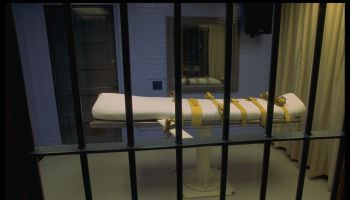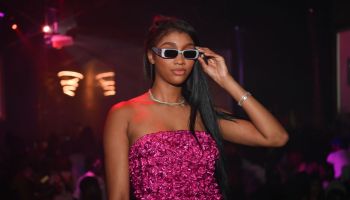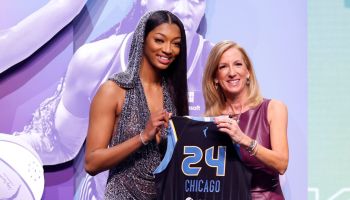By Tika Milan
Tyler Perry gets a lot of criticism for his slap happy Madea character that was embraced by black America and repudiated just the same. His predictable plots have not made him a favorite among movie critics but Perry has made his own lane and is now considered one of the most powerful men in Hollywood. “From beginning to end I felt very grateful to and for Tyler because who else could have done it. The amount of capital that he’s build in this industry, has allowed him to be the person to make this project happen,” gushed Kerry Washington. The all-star cast of Perry’s latest film, For Colored Girls, is like nothing that has ever been done before.
The film brings together a multi-generational line up of black actresses: Kerry Washington, Thandie Newton, Phylicia Rashad, Kimberly Elise, Macy Gray, Whoopi Goldberg, Janet Jackson, Loretta Divine, Anika Noni Rose, and newcomer Tessa Thompson. These women tell the stories from Ntozake Shange’s choreopoem For Colored Girls Who Have Considered Suicide When the Rainbow is Enuf.
Shange’s For Colored Girls isn’t just an Obie and Tony award winning play it’s also a collection of poems that is revered as a crowning achievement in Black Literature. It’s a favorite amongst literary circles, academics, and poets. The play ran for 747 performances on Broadway, is still in print after 35 years, and is a staple of theater classes and college productions. With a cultish following and legions of admirers in the worlds of theater, literature and dance, it’s understandable how Perry almost didn’t make the film version. “It was intimidating work because it means so much to so many people, especially women,” says Perry. “Somebody brought it to me years ago I said no. Then Whoopi brought it to me and said she wanted to do a revival on Broadway I said no. Then somebody else brought it to me and I said no again, than after the fifth time I was like ok God, something’s here.”
Perry submitted to the divine intervention and shot the film in just 30 days in New York and Atlanta. Although the shooting was fairly brief, creating a film like this has its difficulties. The challenge of taking a piece like Shange’s For Colored Girls, where the meaning of the work isn’t just in its text, but also in its spacing on the page, and its rhythm and delivery, is that since so many elements bring such texture to the work, it is easily lost in translation from one medium to another. However, Perry did succeed in bringing the abstract element of the piece to the screen by interspersing the dialog with the actual poems. The rhythm changes some as it goes from dialog to narrative; however, the women shine during the transition. It shows how amazing these actresses are and how important their voices are to the screen as well as the stage.
Loretta Divine was magical as Juanita, or the Lady in Green, an older woman who is still looking for love, making mistakes a woman half her age would while running a women’s health clinic teaching workshops on self-worth and emotional balance. “Juanita had an amazing storyline and I was really excited to play her,” says Divine. “I think many women are going to be able to identify with her. You know, when a man is cheating and a woman lets him back into her life over and over again, the problem isn’t just with him it’s with the overall relationship. I think even though Juanita was smart enough to be a nurse and have all these things organized for women, she still wasn’t listening to herself.”
The stories of these women are centered around tragedy and struggle that in some capacity has been brought about by men. He is definitely not the hero in this film but in most instances a maniacal brute. Thandie Newton remarks, “I think very often men and women are spoken about in opposition which this film seems to be provoking. However, I think the strength of the film is that it’s a testament to the extraordinary collaboration of when a woman and a man come together.”
The true stories of a black woman’s experience is seldom told in Hollywood. Her humanity is limited to being the sum of her parts instead of a whole person. We see this in music videos and films. However, Black women have always been the muse for Perry’s work and he genuinely wants to portray her life differently and truthfully. He also worked very hard to keep the voices authentic. To that, Shange says, “[Perry] got it about 75% correct.”
That other 25% lies in the screenwriting. The dialog isn’t nearly as sophisticated as the actual poems and the outcome is foreseeable in some scenes. The film definitely gets melodramatic at times and the desired effect feels forced. ln Lee Daniel’s film Precious, Monique’s scene stealing soliloquy brought home the overall hopelessness of the entire situation. The last scene of that film compounded all the ugliness in people and society leaving it there to hang over the audience. The several close-up, back to back dramatic monologues in For Colored Girls didn’t have nearly the same effect.
This isn’t a feel good type of film and may not be the best for date night, but it definitely will spark some debate about what should be the focal point of a black woman’s experience and is For Colored Girls just her experience alone. Phylicia Rashad has a different take on it. She says, “We would sit in the make-up trailer and we would all talk about this piece. And it came to us all one day, as a collective, in an instant, that all women in the world are colored girls because the color that Ntozake Shange is referring to has not to do with one’s skin. It has to do with mood, heart, spirit, experience, emotion, expression, understanding, or lack thereof. We understand this piece as an expression of Ntozake as a poet and a playwright.”















